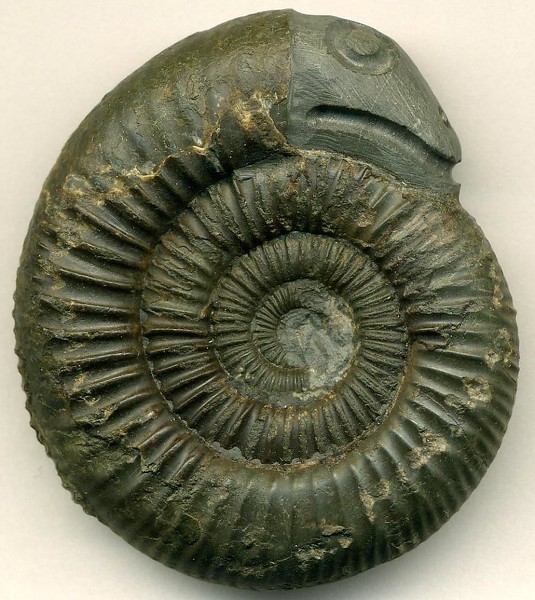Thursday, June 17th, 2021
Focus on Fossils
Lake Campus researchers study ancient sea creature
By Sydney Albert

Submitted Photo
Chuck Ciampaglio, professor of Earth and environmental science at Wright State University-Lake Campus and Wright State alumnus David Peterman discovered how ammonites moved through water.
CELINA - Researchers at Wright State University-Lake Campus are using biomechanics to better understand prehistoric creatures. One recent study earned recognition by the international weekly science journal Nature.
Ammonites are probably one of the most famous organisms from the ancient seas. Though different species evolved different shapes over their existence - some resembled giant spears, and others had shells that looked akin to a tangled set of earbuds - most people likely are most familiar with the spiral-shaped shells found in museums and fossil collections.
Similar to modern-day nautiloids, ammonites made a series of shell chambers as they grew. However, ammonite shells were more fractal, featuring what experts refer to as ammonitic sutures, while the shells of nautiloids are smoother. For scientists who study these prehistoric creatures, why ammonites had such complex shells has been a mystery.
"For over a century, people have tested out all kinds of hypotheses," said Chuck Ciampaglio, a professor of geology and paleontology at the Lake Campus. "A lot of people said, well, it probably strengthens the shell by having all this surface area, right? But you know, people say a lot of things and you need to test things, and it's hard to test if you can't make a model that's close. Well now you can, because you can 3D print these things accurately."
When studies looking at the durability of sutured shells were performed, researchers found the complex shells were actually easier to crush. So Ciampaglio and his graduate student, David Peterman, began coming up with other explanations. They hypothesized those complex shells actually affected the animal's movement, not its durability in the jaws of a predator.
Ammonites had to rise and fall in the water by pumping water into the chambers of its shells, Ciampaglio explained.
"The idea is if you have more and more surface area - those sutures, those weird sutures - it's going to hold more and more of that liquid because of a capillary effect, which gives a faster response time," Ciampaglio said.
Peterman and Ciampaglio accurately designed, 3D printed and tested models of a modern-day nautilus as a baseline before moving on to ammonites. They recreated and tested shells with varying amounts of sutures, as well as shells of different sizes and materials.
"The data was really clear. The more ammonitic the suture, the more it held. It retained its liquid," Ciampaglio said.
The resulting paper was submitted to Nature, which Ciampaglio said published the work quickly. Since the study has been published online, it has received thousands of hits.
The pair didn't stop there. They also worked on testing how different ammonite species swam, wondering if popular recreations were actually accurate. Did the longer, more spear-like ammonites travel parallel to the sea floor as they are often depicted, or did they float along like strange pillars suspended in the water? Ciampaglio said he and Peterman released roughly four or five scientific papers in a year and a half, testing the biomechanics of these ancient sea creatures and finally tested their theories.
"The days of just saying things and not testing things are pretty much over," Ciampaglio said. "We build all kinds of models in here, we test everything."
Using biomechanics to test the possibilities for extinct animals is becoming a more common practice, Ciampaglio said. So much of what humans create is based on designs already found in the natural world; in looking at how prehistoric creatures theoretically lived and functioned, new designs for human technology could also potentially be found.
"The days of digging things up and going 'Oh, isn't this cool?' are kind of over. It's like, okay, how did they live? Why did they go away? What are the big trends?" he said.
Ciampaglio, Peterman and another Lake Campus professor, Stephen Jacquemin, who is known for his studies of water quality in Grand Lake, are collaborating on another biomechanics project involving an extinct shark relative.
Iniopterygians belongs to the more bizarre branch of the larger shark family. It's often depicted as being shaped like a boat hull, with rigid pectoral fins.
"The only other thing that's like that in the modern record are flying fish," Ciampaglio said.
It will never be known with 100% certainty how animals like iniopterygians lived - short of a time machine that allows researchers to observe them. Still, Ciampaglio said its body shape suggests the ancient animal could pick up speed, break the water and glide through the air, much like a flying fish - and, of course, that's what Ciampaglio and his fellow researchers want to test out next.
Ammonites:
Most of these prehistoric marine creatures lived as many as 250 million years ago. They could be the size of a quarter or nine feet long. Like a squid, long "legs" extended from their shells. Known for their distinctive coiled shape, ammonites are among the most common fossils. They are related to the squid and octopus.

Submitted Photo
The end of this ammonite fossil has been carved into a snake's head. In seventh century England, people believed the coiled fossils were snakes turned to stone.

Submitted Photo
These models are of nautilus, marine creatures which exist today. They are modern cousins of ammonites.


